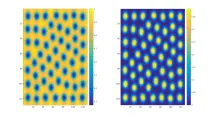Continuing from my previous article on reaction-diffusion process:
Surprise announcement (STATUS : CLOSED) : Those who reproduces the Matlab code from my previous article in python (in the most minimal and optimal way) awaits a surprise gift.
Let me see how many people are viewing and participating in this article. Also do share your videos with different parameters f and k as your articles. Let us see interesting patterns.

Here goes a mini-explanation ofwhat is happening in the system. The associated video is generated using the parameters 'f'=0.0367 and 'k'=0.0649. This resembles a idealized version of cell-division.
Consider 2 chemical species 'U' and 'V' reacting in the form as below.

A single unit of U plus two units of V gives three units of V. Assume these reactions are happening in a 2D plane. Simultaneously V gets into a 'inert' (non-reacting) species 'P'. 'Du' and 'Dv' are respective diffusion coefficients of 'U' and 'V' species. (More of diffusion later. Watch out for future articles!)
'f' is the reaction rate at which the process of addition of 'U' to the system and washing off 'U','V' and 'P' from the system. 'k' is the rate of conversion of 'V' to 'P'.
This system can be written as a differential equations as below:


Reference : https://groups.csail.mit.edu/mac/projects/amorphous/GrayScott/
The inverted delta squared operation is called laplacian and its a spatial second-dervative w.r.t space. Its an averaging action. This will need a better explanation, which I will do in future. My Matlab code in the previous article uses 'cD' and 'cE' to represent 'u' and 'v' variables.
Comment, resteem and upvote this article. Also do follow me. :) bye take care.
▶️ DTube
▶️ IPFS